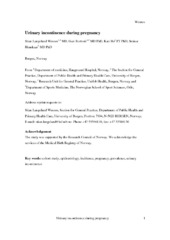| dc.contributor.author | Wesnes, Stian Langeland | en_US |
| dc.contributor.author | Rørtveit, Guri | en_US |
| dc.contributor.author | Bø, Kari | en_US |
| dc.contributor.author | Hunskår, Steinar | en_US |
| dc.date.accessioned | 2013-12-10T13:21:37Z | |
| dc.date.available | 2013-12-10T13:21:37Z | |
| dc.date.issued | 2007-04 | eng |
| dc.Published | Obstetrics & Gynecology 109(4): 922-928 | eng |
| dc.identifier.issn | 0029-7844 | |
| dc.identifier.uri | https://hdl.handle.net/1956/7588 | |
| dc.description.abstract | Objectives: To investigate incidence and prevalence of urinary incontinence during pregnancy, and associated risk factors. Method: The data collection was conducted as part of the Norwegian Mother and Child Cohort Study at the Norwegian Institute of Public Health. We present questionnaire data about urinary incontinence obtained from 43,279 women (response rate 45%) by week 30. We report data on any incontinence in addition to type, frequency and amount of incontinence. Potential risk factors were investigated by logistic regression analyses. Results: The prevalence of incontinence increased from 26% before pregnancy to 58% in week 30. The corresponding figures for nulliparous women were 15% and 48%, and for parous women 35% and 67%. The cumulative incidence was 46%. Stress urinary incontinence was the most common type of incontinence in week 30 of pregnancy, experienced by 31% of nulliparous and 42% of parous women. The majority of pregnant women had leakage less than once a week and droplets only, both before and during pregnancy. Parity was a strong and significant risk factor for incontinence in adjusted analyses both before pregnancy (OR 2.5 (2.4-2.7) for primiparous and OR 3.3 (3.1-3.5) for multiparous women) and during pregnancy (ORs 2.0 (1.9-2.1) and 2.1 (2.0-2.2), respectively). Age and body mass index were weaker, but still statistically significant, risk factors. Conclusions: The prevalence of urinary incontinence increases substantially during pregnancy. Incontinence both before and during pregnancy seems to be associated with parity, age and body mass index. | en_US |
| dc.language.iso | eng | eng |
| dc.publisher | Lippincott, Williams & Wilkins | eng |
| dc.relation.ispartof | <a href="http://hdl.handle.net/1956/7584" target="blank">Urinary incontinence in pregnancy and postpartum. Incidence, prevalence and risk factors</a> | eng |
| dc.subject | Cohort study | eng |
| dc.subject | Epidemiology | eng |
| dc.subject | Incidence | eng |
| dc.subject | Pregnancy | eng |
| dc.subject | Prevalence | eng |
| dc.subject | Urinary incontinence | eng |
| dc.title | Urinary incontinence during pregnancy | en_US |
| dc.type | Peer reviewed | |
| dc.type | Journal article | |
| dc.description.version | acceptedVersion | en_US |
| dc.rights.holder | Copyright 2007 by The American College of Obstetricians and Gynecologists | |
| dc.identifier.doi | https://doi.org/10.1097/01.aog.0000257120.23260.00 | |
| dc.identifier.cristin | 368393 | |
| dc.source.journal | Obstetrics & Gynecology | |
| dc.source.40 | 109 | |
| dc.source.14 | 4 | |
| dc.source.pagenumber | 922-928 | |
